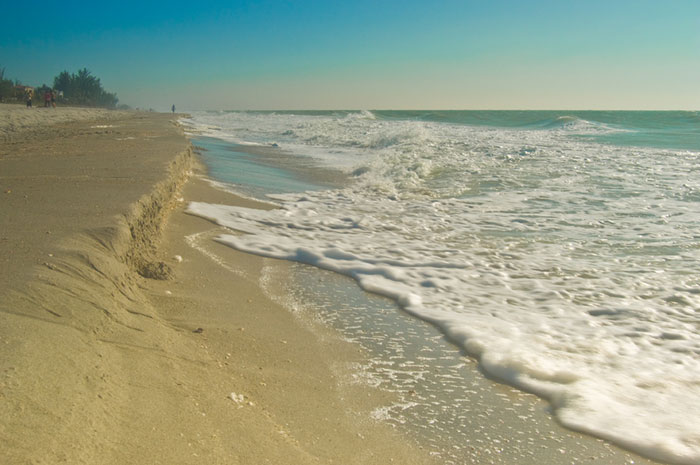Cayo Costa
Sanibel Island •
Captiva Island •
North Captiva Island •
Cayo Costa
Cabbage Key •
Useppa Island •
Boca Grande
Cayo Costa Island, is located directly south of Boca Grande and West of Pine Island. The island is a true treasure of Florida's Gulf coast. Cayo Costa island became a park in 1976 when it was aquisitioned by the state of Florida. The park is 2,416 acres of undisturbed beauty boasting nine miles of beautiful beaches as well as pine forests, oak-palm hammocks, and mangrove swamps.
While enjoying the white, shell filled beaches and serene setting; visitors may see manatees and pods of dolphins in the waters around the park, as well as a spectacular assortment of birds. Cayo Costa is a shell seekers paradise. Shelling is especially good in the winter months. In addition to shelling, you can swim or snorkel in the surf, enjoy the sun, picnic in the shade or hike the seven miles of nature trails. The island is also home to a variety of native wildlife. Bald eagles, ospreys, snakes, gopher tortoises and bobcats are a few of the animals you may encounter.
Cayo Costa's first inhabitants were the Calusa Indians, a mound-building culture, that was centered in Charlotte Harbor. Evidence of the Calusa tribe has been found on many of Florida's barrier islands. There are three Indian mounds thought to have been built by the Calusa on Cayo Costa Island.
In the early nineteenth century, Spanish fishermen from Cuba established "fishing ranchos" on islands along the west coast of Florida. Fish were caught, dried, and then transported to back to Cuba. Two of these ranchos were found on Cayo Costa in 1879 during a survey conducted by the Smithsonian Institution. At that time the island was called "La Costa Island".
In the late nineteenth century a quarantine station was established on the northern end of Cayo Costa for immigrants entering the country through Boca Grande Pass. One of the nature trails, Quarantine Docks Trail, tells the story of this time in the island's history. In the early 1800s, when a ship came in from overseas, they had to dock and wait for the doctor to come aboard and make sure everyone was healthy. However these docks are no longer standing, and the house or structure that held people waiting for quarantine has never been located.
Cayo Costa, was also an early 20th century pioneer fishing village where boats flocked to the docks and talk of the day's catch filled the air. There were about 20 fishing families that lived on Cayo Costa during that time. The community had a school, a post office, a grocery storeand a cemetary. Another of the parks trails, Cemetery Trail, cuts through the heart of Cayo Costa State Park. Along the trail is a small, marked cemetery where members of the Coleman family and Capt. Peter Nelson are buried. There also are a number of unmarked graves throughout the island.
Even with the rich documented history of the island there is also a pirate tale to be told about Cayo Costa. Legend has it that Cayo Costa's second name, Gassparilla Island, comes from the pirate Jose Gasper. Gaspar, a respected, Spanish naval officer who turned pirate reportly settled on the island in the 1700's. Stories about Gasper say he was framed for stealing Spain's crowned jewels by a jilted lover. In 1783, upon hearing news of his imminent arrest and execution, Gaspar commandeered a ship, the Floridablanca, and escaped. Swearing an oath to revenge his treatment by Spanish officials, he resolved to plunder any ship flying the flag of Spain. Gaspar sailed his hijacked ship to the Gulf coast of Florida where he established his base and adopted the name Gasparilla.
For the next 38 years the pirate Gasparilla terrorized ships from all countries, including Spain's. Some report he plundered more then 400 ships during his vicious career. Widely regarded as fearless and ferocious, Gasparilla showed no mercy in battle. He routinely, killed all passengers and crew, with the exception of beautiful women (whom he made concubines). Occasionally, women from wealthy families were held for ransom on close by Captiva Island. Accordingly, Gasparilla and his men used Cayo Costa and other barriar islands as hiding places for thier stolen loot.
In 1821, at age 65, Gasparilla decided it was time to retire. Florida now belonged to the United States and the old pirate found the pressure of the U.S. navy more then he could bear. However, on the day that Gasparilla was to divide the treasure between himself and his men, the U.S. navy attacked Gasparilla and the Floridablanca. Supposedly when the pirate realized he was defeated he climbed to the bow of his ship and yelled "Gasparilla dies by his own hand, not the enemy's". He then wrapped the anchor's chain around his waist and, still holding his cutlass high in one hand, jumped into the dark waters and disappeared.
Only a small portion of Gasparilla's treasure was found. It is believed that about $30 million dollars in gold and jewels still remain hidden around the Gulf coast of Florida.
From the Calusa Indians to fearless pirates and pioneering Cuban fishermen, Cayo Costa has been home to many and yet, has changed little. Cayo Costa offers a rare glimpse of what Florida was like hundreds of years ago. The island is a special place and one our guide's favorite spots to stop. On a trip to Cayo Costa vistors of all ages will enjoy the island's bounty and perhaps, thanks to Gasparilla, someone will dig up more then just sand dollars.

